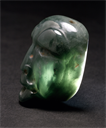Description
This pendant is a miniature mask of the Fat God, a poorly understood being found among the Maya and other early cultures of Mesoamerica. Composed of a highly translucent, rich blue-green jadeite, this masquette is masterfully carved and polished to mirror-like perfection. When viewed in profile, the face appears unusually deep for the dimensions of an Olmec mask. Due to the extensively hollowed out back, however, the piece is wonderfully translucent, especially in the area of the left cheek. Although the eye orbits do not pierce the masquette, a large hole passes through the open mouth. In addition, a pair of biconically drilled holes at the crown of the head provide suspension for the pendant. Although the masquette has drilled nostrils, they are relatively shallow and widely spaced, and no attempt was made at piercing the septum. Despite its highly finished nature, the face retains the remains of drill pits created during carving, including shallow pits flanking the upper bridge of the nose, the left side of the nose, the middle of the upper lip, the juncture of the upper lip and nose, and the corners of the mouth. But rather than suggesting an unfinished quality, these indentations provide a certain sharpness and clarity. Moreover, many of the pits are highly polished, thereby being facet-like sources of shining light. The masquette bears traces of red cinnabar staining in some unpolished or more deeply carved regions.
Although a finely carved piece, this masquette by no means corresponds to typical canons of Olmec beauty. The face is bulbous and fleshy, with a bald, thickly furrowed brow, massive eyebrows and heavy, sagging cheeks. Moreover, the strangely bulging lip spouts almost as if to whistle. On close inspection, it can be seen that the grotesque features protrudes lightly above the rear portion of the masquette, as if these constitute a mask worn by an actual person. Thus the unusual depth of the object may be because the wearer is incorporated into the piece - i.e., the ears and part of the face. This jade pendant seems to portray an individual wearing a mask of the Fat God, as if impersonating this grotesque being during a theatrical performance. Although the Fat God may well represent a sacred clown character of impressive antiquity and longevity, this being appears to be more than a supernatural personification of gluttony. The many Middle and Late Formative monumental stone carvings of the Fat God suggest that it had an important symbolic role in early southeastern Mesoamerica. Along with apparently being a Bacchus-like character of feasting and clowning, the Fat God also may have been an embodiment of the world center, the source of fertility, prosperity, and wealth.
Bibliography
Benson, Elizabeth P. 1969 Supplement to the Handbook of the Robert Woods Bliss Collection of Pre-Columbian Art. Dumbarton Oaks, Trustees for Harvard University, Washington, D. C., cat. 429.
Benson, Elizabeth P. 1981 Some Olmec Objects in the Robert Woods Bliss Collection at Dumbarton Oaks. In The Olmec and Their Neighbors: Essays in Memory of Matthew W. Stirling, Matthew Williams Stirling, Michael D. Coe, David C. Grove and Elizabeth P. Benson, eds., pp. 95-108. Dumbarton Oaks Research Library and Collections, Trustees for Harvard University, Washington, D.C. p. 104-105, figs. 8-9
Taube, Karl A. 2004 Olmec Art at Dumbarton Oaks. Pre-Columbian Art at Dumbarton Oaks; No. 2. Dumbarton Oaks Research Library and Collection, Washington, D.C., p. 156-61, pl. 33.
Acquisition History
Acquired by exchange from Everett Rassiga, New York/Dallas (dealer), by Dumbaton Oaks, 1966.
Dumbarton Oaks Research Library and Collection, Pre-Columbian Collection, Washington, DC.




